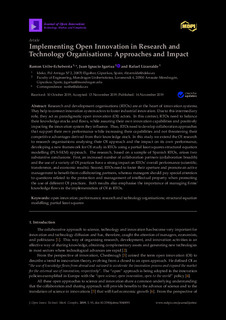| dc.rights.license | Attribution 4.0 International | * |
| dc.contributor.author | Igartua, Juan Ignacio | |
| dc.contributor.other | Uribe-Echeberria Aranzabal, Ramón | |
| dc.contributor.other | Lizarralde Dorronsoro, Rafael | |
| dc.date.accessioned | 2020-03-27T14:28:27Z | |
| dc.date.available | 2020-03-27T14:28:27Z | |
| dc.date.issued | 2019 | |
| dc.identifier.issn | 2199-8531 | en |
| dc.identifier.other | https://katalogoa.mondragon.edu/janium-bin/janium_login_opac.pl?find&ficha_no=155441 | en |
| dc.identifier.uri | https://hdl.handle.net/20.500.11984/1609 | |
| dc.description.abstract | This article seeks to answer the question of how value proposition is created using a human-centred approach in the context of deservitization, in general, and service dilution, in particular. The article aims to describe the Research and development organisations (RTOs) are at the heart of innovation systems. They help to connect innovation system actors to foster industrial innovation. Due to this intermediary role, they act as paradigmatic open innovation (OI) actors. In this context, RTOs need to balance
their knowledge stocks and flows, while assuring their own innovation capabilities and positively impacting the innovation system they influence. Thus, RTOs need to develop collaboration approaches that support their own performance while increasing their capabilities and not threatening their competitive advantages derived from their knowledge stock. In this study we extend the OI research to research organisations analysing their OI approach and the impact on its own performance, developing a new framework for OI study in RTOs using a partial least squares structural equation modelling (PLS-SEM) approach. The research, based on a sample of Spanish RTOs, arises two substantive conclusions. First, an increased number of collaboration partners (collaboration breadth) and the use of a variety of OI practices have a strong impact on RTOs’ overall performance (scientific, transference, and economic results). Second, RTOs need to foster their aperture and promote an active management to benefit from collaborating partners, whereas managers should pay special attention to questions related to the protection and management of intellectual property when promoting the use of different OI practices. Both results also emphasise the importance of managing firms’ knowledge flows in the implementation of OI in RTOs. | en |
| dc.language.iso | eng | en |
| dc.publisher | MDPI AG | en |
| dc.rights | © by the authors | en |
| dc.rights.uri | http://creativecommons.org/licenses/by/4.0/ | * |
| dc.subject | open innovation | en |
| dc.subject | performance | en |
| dc.subject | research and technology organisations | en |
| dc.subject | structural equation modelling | en |
| dc.subject | partial least squares | en |
| dc.title | Implementing Open Innovation in Research and Technology Organisations: Approaches and Impact | en |
| dcterms.accessRights | http://purl.org/coar/access_right/c_abf2 | en |
| dcterms.source | Journal of Open Innovation: Technology, Marketing and Complexity | en |
| local.description.peerreviewed | true | en |
| local.identifier.doi | https://doi.org/10.3390/joitmc5040091 | en |
| local.rights.publicationfee | APC | en |
| local.rights.publicationfeeamount | 747 EUR | |
| local.contributor.otherinstitution | https://ror.org/003qafx79 | es |
| local.source.details | Vol. 5. N. 4. N. artículo 91, 2019 | eu_ES |
| oaire.format.mimetype | application/pdf | |
| oaire.file | $DSPACE\assetstore | |
| oaire.resourceType | http://purl.org/coar/resource_type/c_6501 | en |
| oaire.version | http://purl.org/coar/version/c_970fb48d4fbd8a85 | en |








